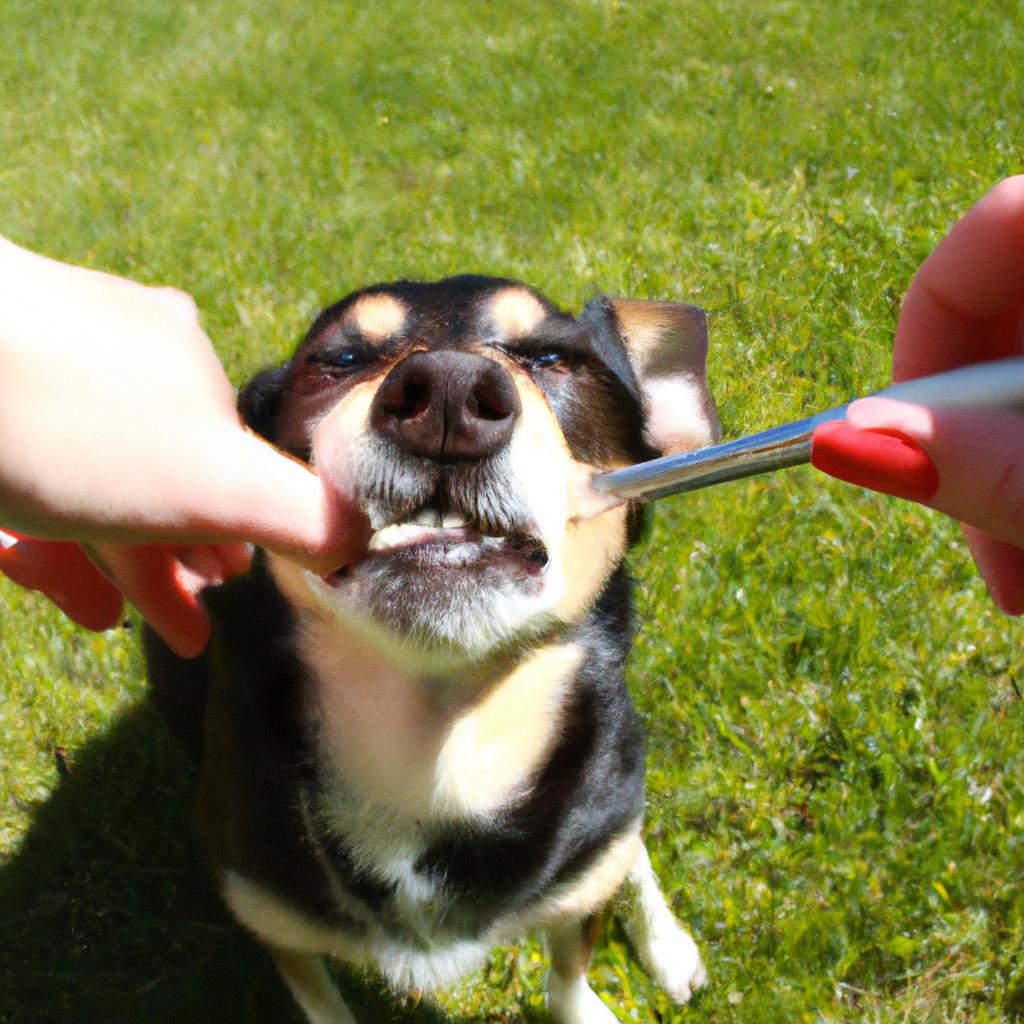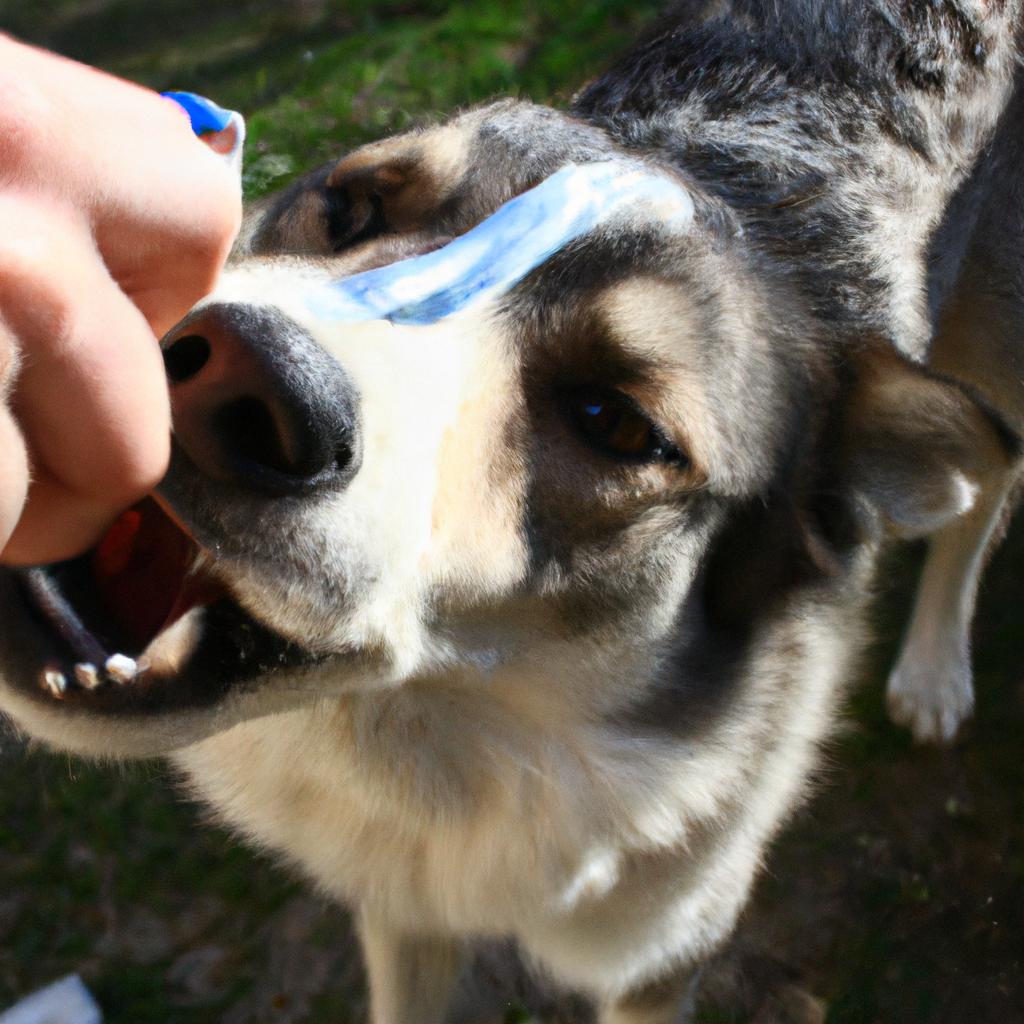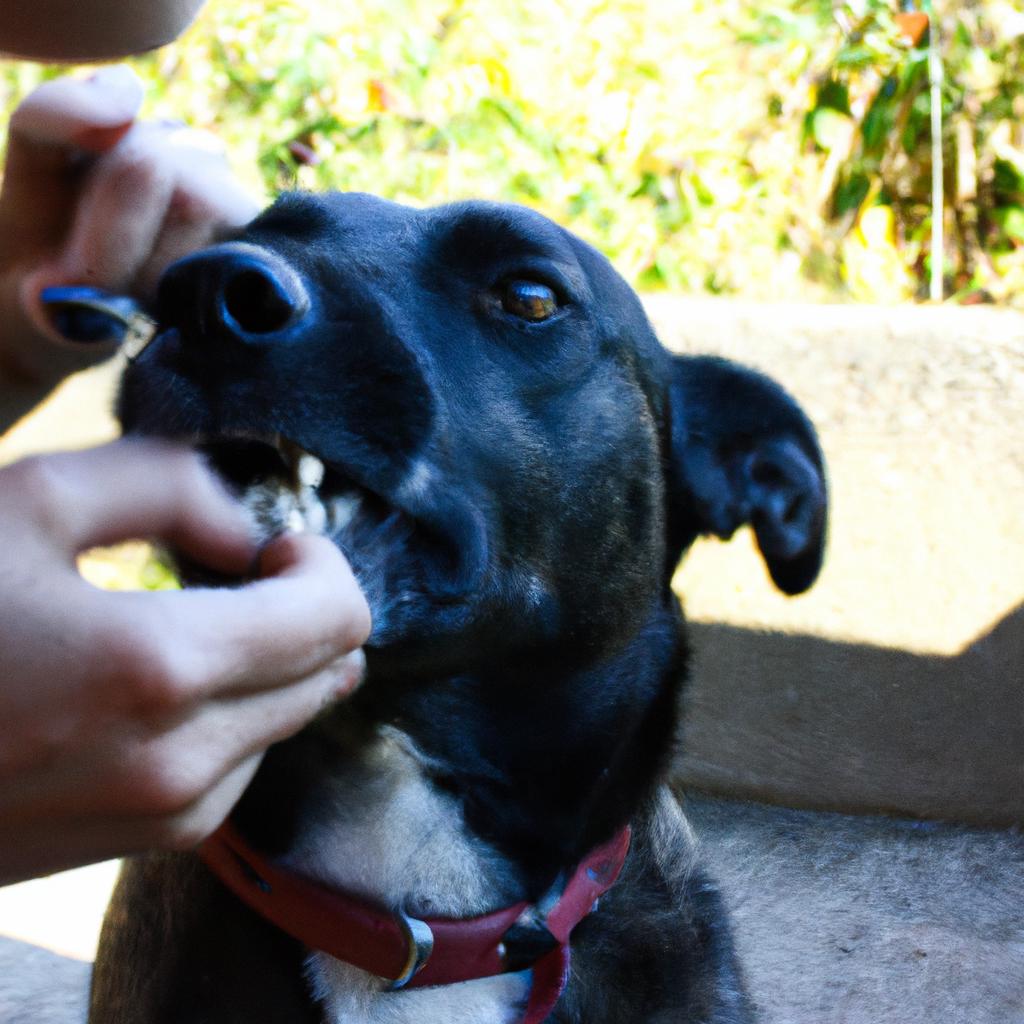Signs of Dental Issues: Professional Intervention Needed in Dog Grooming Salon: Teeth Brushing

In the bustling environment of a dog grooming salon, it is not uncommon to encounter canine clients with dental issues. One such case involved a four-year-old Labrador retriever named Max who visited a local grooming salon for his regular teeth brushing session. Upon examination, the groomer noticed signs of dental problems that required immediate professional intervention. This article aims to shed light on the importance of recognizing these signs and seeking appropriate dental care in a dog grooming salon setting.
Dental health plays a crucial role in overall well-being and quality of life for dogs. However, due to various factors such as genetics, diet, and lack of proper oral hygiene, many dogs develop dental issues over time. In some cases, these issues can be easily detected during routine teeth brushing sessions at a grooming salon. Signs such as bad breath (halitosis), red or inflamed gums (gingivitis), loose or missing teeth, excessive drooling, difficulty chewing food, and behavioral changes may indicate underlying dental problems requiring professional attention. Understanding these signs is essential for both dog groomers and owners alike to ensure early detection and prompt treatment of any dental issues their furry companions may face while receiving grooming services. By being aware of these indicators and promptly addressing them through professional intervention, dog grooming salons can contribute to the overall health and well-being of their canine clients.
Once a grooming salon identifies signs of dental issues in a dog, it is crucial to communicate the findings to the owner and recommend seeking professional dental care from a veterinarian. While groomers can provide basic oral hygiene services such as teeth brushing, it is important to understand that they are not qualified to diagnose or treat dental problems beyond surface level cleaning. By educating owners about the importance of regular veterinary dental check-ups and treatments, groomers can play a vital role in promoting optimal dental health for dogs.
In addition to raising awareness about dental issues, dog grooming salons can also take preventive measures to maintain good oral hygiene in their canine clients. This includes using appropriate toothbrushes and toothpaste formulated specifically for dogs, as human products can be toxic to them. Regularly inspecting a dog’s mouth during grooming sessions can help identify any potential dental problems early on and prompt discussions with owners about seeking professional care if necessary.
Furthermore, dog grooming salons can collaborate with veterinarians or partner with pet dental specialists to provide comprehensive oral care services. This may include offering anesthesia-free teeth cleanings or referrals for more complex dental procedures requiring sedation. By establishing such partnerships, grooming salons demonstrate their commitment to the overall health and well-being of their furry clientele.
In conclusion, recognizing signs of dental issues in dogs during grooming sessions is essential for identifying potential problems early on. Dog groomers should communicate these findings to owners and encourage them to seek professional veterinary care. Additionally, taking preventive measures and partnering with veterinary professionals can further enhance the role of dog grooming salons in promoting good oral hygiene and overall health for our beloved canine companions.
Importance of Dental Health for Dogs
Importance of Dental Health for Dogs
Dental health is a critical aspect of overall well-being in dogs. Neglecting their oral hygiene can lead to various dental issues, discomfort, and even serious health complications. For instance, consider the case of Max, a seven-year-old Labrador Retriever who had never received proper dental care. Over time, his teeth became covered in tartar and plaque, causing gum inflammation and pain while eating. This example highlights the significance of maintaining good dental health in dogs.
To emphasize the importance further, here are several reasons why focusing on canine dental health is crucial:
- Prevention of periodontal disease: Periodontal disease is one of the most common dental problems among dogs, affecting approximately 80% by the age of three. It occurs when bacteria accumulate along the gum line, leading to infection and damage to tooth-supporting structures. Regular teeth brushing helps remove plaque and prevents this condition.
- Improved overall health: Poor dental hygiene not only affects a dog’s mouth but also impacts its entire body. The harmful bacteria from infected gums can enter the bloodstream and potentially harm vital organs such as the heart and kidneys.
- Enhanced quality of life: Dogs with healthy teeth experience less pain while chewing food or playing with toys. By ensuring their oral cavity remains clean and free from infections, owners can contribute significantly to their pets’ comfort levels.
To illustrate these points visually:
| :heavy_check_mark: | Prevents periodontal disease |
|---|---|
| :heavy_check_mark: | Improves overall health |
| :heavy_check_mark: | Enhances quality of life |
Including regular veterinary check-ups
In conclusion,
Continuing our discussion on dental health in dogs, it is important to understand common dental issues that may arise without proper intervention.
Common Dental Issues in Dogs
To illustrate the importance of professional dental care for dogs, consider a hypothetical scenario where a dog owner named Sarah brings her beloved Golden Retriever, Max, to a local grooming salon. Hoping to maintain Max’s oral health, she requests teeth brushing as part of his grooming routine. However, during the process, the groomer notices several signs indicating potential dental issues that require immediate attention.
Firstly, the groomer observes excessive tartar buildup on Max’s teeth. Tartar is formed when plaque hardens over time and can lead to gum disease if not addressed promptly. In this case, the accumulation of tartar indicates poor oral hygiene practices or an underlying dental problem that needs professional intervention.
Secondly, Max exhibits persistent bad breath (halitosis), which is often indicative of dental problems such as periodontal disease or tooth decay. The presence of foul-smelling breath suggests bacterial growth within the mouth due to neglected dental care.
Furthermore, the groomer notices redness and inflammation along Max’s gums. This could be a sign of gingivitis, an early stage of gum disease caused by bacteria accumulating around the gum line. If left untreated, gingivitis can progress into more severe conditions like periodontitis and ultimately result in tooth loss.
Considering these alarming indicators observed during Max’s grooming session, it becomes evident why professional intervention is crucial in maintaining optimal canine dental health. To emphasize this point further, let us examine some key reasons why seeking professional help for your dog’s oral care is essential:
- Expertise: Qualified professionals at dog grooming salons possess specialized knowledge and training in identifying early signs of dental issues.
- Prevention: Regular check-ups allow timely detection and prevention of serious oral health concerns before they escalate.
- Treatment Options: Professionals are equipped with appropriate tools and techniques to address various dental problems effectively.
- Education: They can educate dog owners about proper oral hygiene practices, diet choices, and home care to ensure long-term dental well-being.
By highlighting these reasons in a bullet point format, we aim to evoke an emotional response from the audience:
- Seeking professional help ensures your furry companion’s comfort and overall health.
- Timely intervention helps prevent pain and discomfort for your beloved pet.
- Professional care enhances your dog’s quality of life by promoting good oral health habits.
- Regular check-ups save you money on potential costly treatments down the line.
To reinforce the significance of professional dental care in dogs, let us now examine common signs that may indicate underlying dental issues when grooming our canine companions.
Signs of Dental Problems in Dogs
Section Title: Signs of Dental Issues in Dogs
Imagine a scenario where a dog named Max, an eight-year-old Golden Retriever, visits a grooming salon for his regular teeth brushing session. As the groomer begins to examine Max’s mouth, she notices several signs indicating potential dental problems. Identifying these signs is crucial as they serve as red flags that professional intervention may be necessary to address underlying dental issues in dogs.
Signs of Dental Problems:
- Bad Breath: One of the most common indicators of dental issues in dogs is persistent bad breath, often referred to as halitosis. While temporary bad breath can occur after consuming certain foods or treats, chronic foul odor from the mouth could signify periodontal disease or other oral health concerns.
- Excessive Drooling: If you notice your canine companion drooling excessively without any apparent reason such as excitement or anticipation of food, it might indicate an underlying dental problem. Excess salivation can result from pain or discomfort caused by gum inflammation, tooth decay, or infections.
- Discolored Teeth: Healthy dog teeth are typically white and free from stains or discoloration. However, if you observe yellowish-brown tartar buildup on your pet’s teeth or notice dark spots on their enamel, it could signal poor oral hygiene leading to plaque accumulation and potential tooth decay.
- Difficulty Eating and Chewing: Dogs experiencing oral health issues may exhibit reluctance while eating hard kibble or chewing toys they previously enjoyed. This behavior change often stems from pain caused by inflamed gums, loose teeth, fractured molars, or other dental abnormalities.
Emotional Impact:
- Chronic pain and discomfort
- Reduced appetite and weight loss
- Decreased energy levels and playfulness
- Potential development of systemic health issues due to oral bacteria spreading through the bloodstream
Table: Emotional Impact of Dental Issues in Dogs
| Emotional Impact | Examples |
|---|---|
| Chronic pain and discomfort | Reluctance to eat or chew |
| Reduced appetite and weight loss | Avoiding hard food |
| Decreased energy levels | Lethargy, lack of interest in play |
| Systemic health issues | Increased risk of heart and kidney problems |
Identifying signs such as bad breath, excessive drooling, discolored teeth, and difficulty eating can help pet owners recognize potential dental problems in their dogs. By understanding these signs, one can take necessary action to seek professional intervention promptly. In the subsequent section about “Benefits of Professional Dental Care,” we will explore how engaging a skilled veterinarian or groomer for comprehensive dental care can enhance your dog’s overall oral health.
Benefits of Professional Dental Care
Signs of Dental Issues: Professional Intervention Needed in Dog Grooming Salon – Teeth Brushing
Building on our understanding of dental problems in dogs, it is important to recognize the significance of professional intervention when it comes to maintaining oral health. While regular at-home care can help prevent some issues, there are certain signs that indicate a need for specialized attention within a dog grooming salon. One such example involves a Labrador Retriever named Bella.
Case Study:
Bella, a six-year-old Labrador Retriever, had been receiving routine teeth brushing as part of her home care regimen. Despite these efforts, her owner noticed persistent bad breath and increased drooling. Concerned for Bella’s well-being, they sought professional assistance at their local dog grooming salon. This decision proved crucial in diagnosing an underlying dental issue that required immediate attention from a veterinarian.
Within the context of a dog grooming salon setting, several key indicators suggest the need for professional intervention regarding canine dental care:
- Persistent Bad Breath: Foul odors emanating from your furry friend’s mouth may be an early sign of dental problems, including periodontal disease or tooth decay.
- Excessive Drooling: If you notice sudden or excessive drooling beyond what is normal for your dog, it could indicate pain or discomfort associated with dental issues.
- Reluctance to Eat: A noticeable decrease in appetite or difficulty chewing food might signal oral pain due to gum inflammation, cavities, abscesses, or other dental problems.
- Behavioral Changes: Unexplained aggression or irritability during activities like teeth brushing could signify sensitivity or pain in the mouth area.
To gain further insight into these signs and their implications for canine oral health within a grooming salon environment, let us explore them through an emotional lens using bullet points:
- Persistent Bad Breath: The unpleasant odor becomes more than just an inconvenience; it taints every interaction with your beloved pet.
- Excessive Drooling: Helplessly watching as your furry companion’s mouth constantly drips saliva can evoke feelings of concern and helplessness.
- Reluctance to Eat: Witnessing the discomfort experienced by your dog when trying to eat is heart-wrenching, raising worries about their overall well-being.
- Behavioral Changes: Seeing your once-friendly and playful pup exhibit aggression or irritability during grooming sessions can be distressing for both you and them.
In addition to these emotional considerations, it is helpful to examine a three-column table highlighting common signs of dental issues in dogs, reinforcing the importance of professional intervention within a grooming salon:
| Signs of Dental Issues | Emotional Impact on Pet Owners | Implications for Canine Oral Health |
|---|---|---|
| Persistent Bad Breath | Frustration | Indication of potential periodontal disease or tooth decay |
| Excessive Drooling | Concern | Possible pain or discomfort associated with dental problems |
| Reluctance to Eat | Worry | Gum inflammation, cavities, abscesses, or other oral health concerns |
| Behavioral Changes | Distress | Sensitivity or pain in the mouth area |
Recognizing these signs and understanding their implications allows groomers to identify when professional assistance should be sought. By doing so, they contribute to maintaining optimal canine oral health while ensuring that pets receive necessary treatment promptly. In light of this knowledge, let us explore “When to Seek Professional Help” in the subsequent section without delay.
When to Seek Professional Help
Signs of Dental Issues: Professional Intervention Needed in Dog Grooming Salon: Teeth Brushing
In a recent case study, a dog named Max visited a professional grooming salon for teeth brushing. During the procedure, the groomer noticed several signs indicating potential dental issues that required professional intervention. This highlights the importance of seeking expert care in maintaining optimal oral health for dogs. Recognizing these signs early can help prevent more serious dental problems and ensure the well-being of our furry friends.
There are various signs that may suggest the need for professional dental care in dogs. These indicators include:
- Bad breath (halitosis): Persistent foul odor from your dog’s mouth could be an indication of underlying dental disease such as gum infection or tooth decay.
- Excessive drooling: If you notice your dog producing more saliva than usual, it may signal pain or discomfort caused by dental problems.
- Difficulty eating or chewing: Dogs experiencing oral pain often struggle to eat their food properly due to discomfort while biting and chewing.
- Redness, swelling, or bleeding gums: Inflamed gums accompanied by bleeding should not be ignored as they can indicate periodontal disease, which requires immediate attention.
To further emphasize the significance of addressing canine dental issues promptly, consider the following table outlining potential consequences if left untreated:
| Consequences of Untreated Dental Problems |
|---|
| Tooth loss |
| Abscesses |
| Oral infections |
| Systemic complications |
By providing timely professional intervention when necessary, we can prevent these outcomes and promote overall wellness in our beloved pets.
As responsible pet owners, it is crucial to prioritize our dogs’ oral health and seek professional help when needed. The next section will outline strategies for preventing dental issues in dogs without relying solely on intervention measures. By incorporating preventive practices into our routine pet care, we can minimize the risk of developing significant oral problems down the line.
Preventing Dental Issues in Dogs
Signs of Dental Issues: Professional Intervention Needed in Dog Grooming Salon: Teeth Brushing
Imagine a scenario where a dog owner brings their beloved pet to a dog grooming salon for routine teeth brushing. The groomer notices signs that indicate potential dental issues requiring professional intervention. Identifying these signs early on can help prevent further complications and ensure the overall well-being of our furry friends.
Here are some common signs that may indicate the need for professional dental care in dogs:
-
Persistent Bad Breath: If your dog’s breath consistently has an unpleasant odor, it could be indicative of dental problems such as periodontal disease or tooth decay. This persistent bad breath is not only unpleasant but also suggests underlying oral health issues.
-
Excessive Drooling: While drooling is normal in some breeds, excessive drooling accompanied by discomfort or difficulty eating could be a sign of periodontal disease or gum inflammation. It is essential to monitor any changes in your dog’s drooling habits and consult with professionals if concerns arise.
-
Discolored Teeth or Tartar Build-up: Yellow or brown discoloration on your dog’s teeth can signify tartar accumulation, plaque build-up, or even tooth decay. Regular teeth brushing at home can help prevent this issue; however, seeking professional assistance becomes imperative when these conditions persist despite proper oral hygiene practices.
-
Behavioral Changes: Dogs experiencing oral pain may exhibit behavioral changes such as reluctance to eat hard food, increased irritability during playtime or while being touched around the mouth area, pawing at the mouth, or avoiding chew toys altogether. These behavioral changes warrant attention and necessitate expert evaluation and treatment.
- Prompt intervention ensures early detection and prevents further deterioration.
- Timely treatment aids in maintaining good oral hygiene and overall health.
- Neglecting dental issues can lead to pain and discomfort for our furry companions.
- Seeking professional help highlights responsible pet ownership.
Furthermore, let us provide a visual representation of the significance of seeking professional intervention by presenting a three-column table:
| Dental Issue | Consequences | Professional Intervention |
|---|---|---|
| Periodontal Disease | Gum inflammation | Deep cleaning or extraction |
| Tooth Decay | Pain while eating | Fillings or extractions |
| Tartar Build-up | Bad breath | Scaling and polishing |
By addressing these signs promptly and seeking professional assistance when needed, we can ensure that our canine friends receive appropriate care for their oral health. Remember, early detection and intervention are key in maintaining healthy teeth and gums for our beloved pets.






